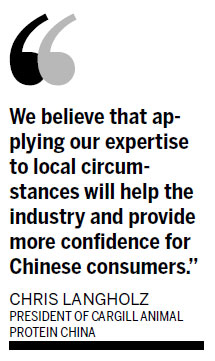


Cargill Inc, the United States-based agricultural and industrial conglomerate, has opened its first China poultry production base in Chuzhou, Anhui province, with an investment of $250 million.
The project, initiated in 2009, is part of Cargill's ongoing strategy to further diversify in China. It has the capacity to process 65 million chickens and 176,000 tons of poultry products annually, about 1 percent of China's poultry production capacity.
Chris Langholz, president of Cargill animal protein China, said for new growth drivers, the most obvious is the modernization of livestock and the food supply chain.
Food consumption is normally a clear indicator of an economy and the size of its population. In China, meat consumption is rising and people are eating a broader variety of meat. Meat products have become more sophisticated and consumers now look more for healthy and convenient food.
"If you believe that China's incomes will continue to rise, then this sector - animal protein - will be very strong. This is one of the reasons we see a lot of investment by both Chinese and international companies in all of these areas," said Langholz.
In 2012, chicken consumption in China exceeded 13 million tons, the first time that more chicken was eaten in China than in the US, according to a study released by the Chinese Academy of Agricultural Sciences in July.
Cargill plans to invest another $50 million to establish a deep-processing plant in Chuzhou. This plant is expected to open next June.
The site in Chuzhou is close to many major cities in East China, such as Nanjing, Hefei, Hangzhou and Shanghai.
The fully integrated project will feature 12 broiler breeder plants, 35 chicken farms, one slaughterhouse, one feed plant and two chicken processing factories.
"We believe that applying our expertise to local circumstances will help the industry and provide more confidence for Chinese consumers," Langholz said.
Langholz said the new facilities' food safety systems are supported by foundational programs such as sanitation for processing equipment, proper personal hygiene, pest control, maintenance, product labeling, traceability and other key programs.
In recent months, Cargill sent 400 employees for professional training to Thailand, where the poultry industry has world-class technology and management methods.
Gary Locke, the US ambassador to China, said Cargill's investment in Anhui province is a shining example of how US-China agricultural cooperation can help China ensure that its people have a safe and reliable source of poultry, while simultaneously strengthening bilateral economic and agricultural ties.
"I firmly believe that when our two countries are able to deepen our commercial partnerships, we can bring positive, long-term benefits to the consumers of both our countries," said Locke.
Cargill entered China in 1972, and has since moved into different products ranging from animal proteins and grains to oilseeds. Cargill (China) has more than 8,000 employees and 52 plants across the country.
Qiu Baoqin, deputy secretary-general of the Beijing-based China National Poultry Industry Association, said urbanization and rising incomes will continue to boost meat consumption growth in more second- and third-tier cities in China, where per capita incomes are below $5,000.
"As Chinese consumers become more demanding in preparing their meals, they are paying close attention to their health and beginning to choose poultry over pork, the traditional protein staple in China," Qiu said.
"Poultry such as duck, goose, yellow-skin and white-feather chicken have less fat and more protein than pork."
 2013 Beijing Intl Jewelry Expo kicks off
2013 Beijing Intl Jewelry Expo kicks off
 Microsoft revamps Surface to challenge Apple
Microsoft revamps Surface to challenge Apple
 Highlights of AOPA-China Fly-In air show
Highlights of AOPA-China Fly-In air show
 Car Free Day to fight air pollution
Car Free Day to fight air pollution
 Liaoning carrier completes its furthest sea trial
Liaoning carrier completes its furthest sea trial
 798 Art Festival kicks off in Beijing
798 Art Festival kicks off in Beijing
 Intl comic festival 'Comicopolis' held in Buenos Aires
Intl comic festival 'Comicopolis' held in Buenos Aires
 Highlights of CIAPE 2013
Highlights of CIAPE 2013